Developing Intelligent Integrated Solutions to Improve Pedestrian Safety for Sustainable Urban Mobility
Abstract
1. Introduction
- State Traffic Inspectorate. Information on road safety indicators. (http://stat.gibdd.ru/ accessed on 7 September 2025);
- Road accident statistics in Russia (https://rusdtp.ru/stat-dtp/ accessed on 7 September 2025);
- 2024 Statistics for Accidents Caused by Pedestrians (https://journal.ab-club.ru/news/statistika-dtp-po-vine-peshehodov-2024/ accessed on 7 September 2025);
- Pedestrian accident statistics in Russia (https://myseldon.com/ru/news/index/334620553 accessed on 7 September 2025).
2. Problem Background: Measures to Ensure Pedestrian Safety
2.1. Study of Pedestrian Behavior Patterns and Identification of the Most Critical Factors Influencing Safety
2.2. Infrastructure Solutions to Reduce Accidents
2.3. The Influence of Pedestrian Characteristics and Their Behavior on Traffic Safety
3. Materials and Methods
- pedestrian patterns whose behavior creates risky situations,
- what types of risks exist for pedestrians and what external factors can cause them,
- what solutions are implemented to prevent and reduce the severity of consequences in the event that a risky situation does occur.
3.1. Risks Due to the Characteristics of Pedestrian Groups and Their Behavior Patterns
3.2. DSS and Its Modules for Responding to Risks and Developing Measures to Prevent Incidents
3.2.1. Grouping Data by the Method of Their Use
3.2.2. Data Storage and Administration Module
3.2.3. Data Processing Module
3.2.4. Decision-Making Module
3.3. Materials and Methodologies Used in the Study
3.3.1. Development of a Pedestrian Classifier
3.3.2. Choosing the Least Dangerous Route
3.3.3. Using Simulation Models to Analyze Infrastructure Change Solutions
3.4. Justification of Reproducibility of Methods and Results
4. Results and Discussion
4.1. DSS Structure
4.2. Pedestrian Classification and Intelligent Analysis in Route Selection
4.3. Using Traffic Light with Pedestrian Button as a Way to Improve Pedestrian Safety
5. Conclusions
5.1. Conclusions of the Study
5.2. Limitations of the Study and Future Directions
Author Contributions
Funding
Institutional Review Board Statement
Informed Consent Statement
Data Availability Statement
Conflicts of Interest
References
- Avsec, S.; Jagiełło-Kowalczyk, M.; Żabicka, A.; Gil-Mastalerczyk, J.; Gawlak, A. Human-Centered Systems Thinking in Technology-Enhanced Sustainable and Inclusive Architectural Design. Sustainability 2024, 16, 9802. [Google Scholar] [CrossRef]
- Lee, S.H. Transformation by Human—Centered System Design. Des. Manag. Rev. 2024, 35, 88–93. [Google Scholar] [CrossRef]
- European Commission. European Road Safety Observatory: Road Safety Thematic Report—Personal Mobility Devices. Brussels, European Commission, Directorate General for Transport. 2021, pp. 1–22. Available online: https://road-safety.transport.ec.europa.eu/document/download/6f698f20-f43f-4066-816a-d1db217b3bc4_en?filename=road_safety_thematic_report_personal_mobility_devices_tc_final.pd (accessed on 15 September 2025).
- Emerging Modes of Personal Transportation. Available online: https://www2.gov.bc.ca/gov/content/transportation/driving-and-cycling/cycling/personal-mobility-devices (accessed on 31 July 2025).
- Rules for Personal Mobility Devices. Available online: https://www.qld.gov.au/transport/safety/rules/wheeled-devices/personal-mobility-devices (accessed on 17 September 2025).
- Shared Micromobility in the U.S. and Canada: 2023. Available online: https://nacto.org/wp-content/uploads/Shared-micro-in-2023-snapshot_FINAL_July22-2024.pdf (accessed on 15 September 2025).
- Sun, S.; Ertz, M. Can shared micromobility programs reduce greenhouse gas emissions: Evidence from urban transportation big data. Sustain. Cities Soc. 2022, 85, 104045. [Google Scholar] [CrossRef]
- Resolution Adopted by the General Assembly on 31 August 2020. Available online: https://docs.un.org/en/A/RES/74/299 (accessed on 17 September 2025).
- Global Road Safety. Available online: https://www.roadsafety.gov.au/global (accessed on 17 September 2025).
- National Project “Infrastructure for Life”. Available online: https://minstroyrf.gov.ru/trades/natsionalnye-proekty/natsionalnyy-proekt-infrastruktura-dlya-zhizni/ (accessed on 17 September 2025).
- Deluka-Tibljaš, A.; Šurdonja, S.; Ištoka Otković, I.; Campisi, T. Child-Pedestrian Traffic Safety at Crosswalks—Literature Review. Sustainability 2022, 14, 1142. [Google Scholar] [CrossRef]
- Gogola, M.; Ondruš, J. Road Safety Perspective of Small Children. In Proceedings of the 2020 XII International Science-Technical Conference AUTOMOTIVE SAFETY, Kielce, Poland, 21–23 October 2020; pp. 1–5. [Google Scholar] [CrossRef]
- Ištoka Otković, I.; Deluka-Tibljaš, A.; Zečević, Đ.; Šimunović, M. Reconstructing Intersection Conflict Zones: Microsimulation-Based Analysis of Traffic Safety for Pedestrians. Infrastructures 2024, 9, 215. [Google Scholar] [CrossRef]
- Otković, I.I.; Deluka-Tibljaš, A.; Šurdonja, S.; Campisi, T. Analysis of influencing parameters on children’s crossing speeds at non-signalized crosswalks using neural network models. Transp. Res. Procedia 2025, 90, 543–550. [Google Scholar] [CrossRef]
- Yang, J.; Gauli, N.; Shiwakoti, N.; Tay, R.; Deng, H.; Chen, J.; Nepal, B.; Li, J. Examining the Factors Influencing Pedestrian Behaviour and Safety: A Review with a Focus on Culturally and Linguistically Diverse Communities. Sustainability 2025, 17, 6007. [Google Scholar] [CrossRef]
- Habibzadeh, M.; Mirabimoghaddam, M.H.; Haghighi, S.M.S.; Ameri, M. Presentation of artificial neural network models based on optimum theories for predicting accident severity on rural roads in Iran. Transp. Res. Interdiscip. Perspect. 2024, 25, 101090. [Google Scholar] [CrossRef]
- Ostadtaghizadeh, A.; Kouchakinejad-Eramsadati, L.; Asgary, A.; Homaie Rad, E.; Hirshon, J.M. Factors Influencing Pedestrian Traffic Collision in Iran: A Qualitative Content Analysis. Bull. Emerg. Trauma 2025, 13, 2–13. [Google Scholar] [CrossRef]
- Kim, S.; Choi, S.; Kim, B.H.S. Analysis of factors affecting pedestrian safety for the elderly and identification of vulnerable areas in Seoul. Accid. Anal. Prev. 2025, 211, 107878. [Google Scholar] [CrossRef]
- Lee, S.; Han, M.; Rhee, K.; Bae, B. Identification of Factors Affecting Pedestrian Satisfaction toward Land Use and Street Type. Sustainability 2021, 13, 10725. [Google Scholar] [CrossRef]
- Marić, B.; Lipovac, K.; Nešić, M.; Đerić, M. The Influence of a Countdown Display on Pedestrian Behavior at a Signalized Pedestrian Crossing Equipped with a Pedestrian Refuge Island. Transp. Res. Procedia 2021, 55, 1720–1728. [Google Scholar] [CrossRef]
- Kopsacheilis, A.; Politis, I. Exploring factors influencing pedestrian accident severity: A multi-source study in the city of Berlin. Eur. Transp. Res. Rev. 2024, 16, 63. [Google Scholar] [CrossRef]
- Swami, M.; Pathak, C.; Swami, S.; Jeihani, M. Promoting Sustainable Mobility: A Walkability Analysis for School Zone Safety. Sustainability 2024, 16, 9118. [Google Scholar] [CrossRef]
- Mukherjee, D.; Abhinay, K. Identification of Factors Influencing Pedestrian Perceived Safety and Satisfaction Level Using Ordered Logit Models in an Indian Midsized City. Int. J. Transp. Dev. Integr. 2024, 8, 283–299. [Google Scholar] [CrossRef]
- Mukherjee, D. Assessing pedestrian safety at urban signalized intersections across various land use types: Insights from a mid-sized Indian city. Discov. Appl. Sci. 2025, 7, 384. [Google Scholar] [CrossRef]
- Prakash, S.; Karuppanagounder, K. Parametric Study on the Influence of Pedestrians’ Road Crossing Pattern on Safety. Open Transp. J. 2023, 17, e187444782303140. [Google Scholar] [CrossRef]
- Hari, K.C.; Thusitha, S. Assessment of Pedestrian Safety at Crosswalks of Unsignalized Intersection: A Case Study of Machhapokhari Intersection, Kathmandu. J. Transp. Syst. Eng. 2025, 1, 25–36. [Google Scholar] [CrossRef]
- Ristić, B.; Bogdanović, V.; Stević, Z. Urban Evaluation of Pedestrian Crossings Based on Start-Up Time Using the MEREC-MARCOS Model. J. Urban Dev. Manag. 2024, 3, 34–42. [Google Scholar] [CrossRef]
- Santilli, D.; D’Apuzzo, M.; Evangelisti, A.; Nicolosi, V. Towards Sustainability: New Tools for Planning Urban Pedestrian Mobility. Sustainability 2021, 13, 9371. [Google Scholar] [CrossRef]
- Jurak, J.; Ćosić, M.; Tišljar, A.; Nemet, I. Promoting safer and more sustainable urban mobility: Exploring reduced speed limits for improved road safety in urban environments. Transp. Res. Procedia 2025, 83, 465–471. [Google Scholar] [CrossRef]
- Ziółkowski, R.; Pérez-Acebo, H.; Gonzalo-Orden, H.; Linares-Unamunzaga, A. Changes in Safety Performance on Single-Carriageway Roads After Installation of Additional Lighting at Pedestrian Crossing. Land 2024, 13, 2134. [Google Scholar] [CrossRef]
- Kruszyna, M.; Matczuk-Pisarek, M. The Effectiveness of Selected Devices to Reduce the Speed of Vehicles on Pedestrian Crossings. Sustainability 2021, 13, 9678. [Google Scholar] [CrossRef]
- Cieśla, M. Modern Urban Transport Infrastructure Solutions to Improve the Safety of Children as Pedestrians and Cyclists. Infrastructures 2021, 6, 102. [Google Scholar] [CrossRef]
- Charef, A.; Jarir, Z.; Quafafou, M. Optimizing Traffic Flow and Pedestrian Safety: The Role of Crosswalk Distance in Roundabout Design. In Proceedings of the 2024 International Conference on Global Aeronautical Engineering and Satellite Technology (GAST), Marrakesh, Morocco, 24–26 April 2024; pp. 1–6. [Google Scholar] [CrossRef]
- Zhang, Y.; Zhang, X.; Fujinami, Y.; Raksincharoensak, P. Social Force Model-Based Adaptive Parameters Collision Avoidance Method Considering Motion Uncertainty of the Pedestrian. IEEE Access 2024, 12, 794–809. [Google Scholar] [CrossRef]
- Zhang, C.; Sprenger, J.; Ni, Z.; Berger, C. Predicting and Analyzing Pedestrian Crossing Behavior at Unsignalized Crossings. In Proceedings of the 2024 IEEE Intelligent Vehicles Symposium (IV), Jeju Island, Republic of Korea, 2–5 June 2024; pp. 674–681. [Google Scholar] [CrossRef]
- Mátyás, E.; Szabó, L. Intelligent Illumination of Crosswalks for Increasing Pedestrian Safety. In Proceedings of the 2024 IEEE International Conference on Automation, Quality and Testing, Robotics (AQTR), Cluj-Napoca, Romania, 16–18 May 2024; pp. 1–6. [Google Scholar] [CrossRef]
- Pogatsnik, M.; Fischer, D.; Nagy, L.; Dora, S. Autonomous Pedestrian Crossing in Smart City Environment. In Proceedings of the 2020 IEEE 24th International Conference on Intelligent Engineering Systems (INES), Reykjavík, Iceland, 8–10 July 2020; pp. 37–42. [Google Scholar] [CrossRef]
- Wickramasinghe, K.S.; Ganegoda, G.U. Pedestrian Detection, Tracking, Counting, Waiting Time Calculation and Trajectory Detection for Pedestrian Crossings Traffic Light Systems. In Proceedings of the 20th International Conference on Advances in ICT for Emerging Regions (ICTer), Colombo, Sri Lanka, 4–7 November 2020; pp. 172–177. [Google Scholar] [CrossRef]
- Deshmukh, S.; Parwekar, A.; Danej, B.; Chavhan, N.A.; Agrawal, R.; Dhule, C. Machine Learning Algorithm Comparison for Traffic Signal: A Design Approach. In Proceedings of the 8th International Conference on Communication and Electronics Systems (ICCES), Coimbatore, India, 1–3 June 2023; pp. 1107–1114. [Google Scholar] [CrossRef]
- Gao, L. Design of Intelligent Zebra Crossing System Based on Cloud-Network Convergence. In Proceedings of the 7th International Conference on Intelligent Computing and Signal Processing (ICSP), Xi’an, China, 15–17 April 2022; pp. 1332–1335. [Google Scholar] [CrossRef]
- Lozano Domínguez, J.M.; Redondo González, M.J.; Davila Martin, J.M.; Mateo Sanguino, T.D.J. Using Sensor Fusion and Machine Learning to Distinguish Pedestrians in Artificial Intelligence-Enhanced Crosswalks. Electronics 2023, 12, 4718. [Google Scholar] [CrossRef]
- Ezzati Amini, R.; Katrakazas, C.; Antoniou, C. Negotiation and Decision-Making for a Pedestrian Roadway Crossing: A Literature Review. Sustainability 2019, 11, 6713. [Google Scholar] [CrossRef]
- Kim, D.; Kim, H.; Mok, Y.; Paik, J. Real-Time Surveillance System for Analyzing Abnormal Behavior of Pedestrians. Appl. Sci. 2021, 11, 6153. [Google Scholar] [CrossRef]
- Deokar, S.; Khandekar, S. Identification of Pedestrian Movement and Classification Using Deep Learning for Advanced Driver Assistance System. In Proceedings of the 2022 International Conference on Augmented Intelligence and Sustainable Systems (ICAISS), Trichy, India, 24–26 November 2022; pp. 374–381. [Google Scholar] [CrossRef]
- Giannoulaki, M.; Christoforou, Z. Pedestrian Walking Speed Analysis: A Systematic Review. Sustainability 2024, 16, 4813. [Google Scholar] [CrossRef]
- Sajewicz, J.; Dziuba-Słonina, A. Texting on a Smartphone While Walking Affects Gait Parameters. Int. J. Environ. Res. Public Health 2023, 20, 4590. [Google Scholar] [CrossRef]
- Hasan, R.; Hoque, M.A.; Karim, Y.; Griffin, R.; Schwebel, D.C.; Hasan, R. Someone to Watch Over You: Using Bluetooth Beacons for Alerting Distracted Pedestrians. IEEE Internet Things J. 2022, 9, 23017–23030. [Google Scholar] [CrossRef] [PubMed]
- Marrapu, A. Utilizing Technology to Prevent Distracted Walking. In Proceedings of the 2024 IEEE Integrated STEM Education Conference (ISEC), Princeton, NJ, USA, 9 March 2024; pp. 1–7. [Google Scholar] [CrossRef]
- Mikusova, M.; Wachnicka, J.; Zukowska, J. Research on the Use of Mobile Devices and Headphones on Pedestrian Crossings—Pilot Case Study from Slovakia. Safety 2021, 7, 17. [Google Scholar] [CrossRef]
- Koike, Y.; Tanjo, Y. Development of a Navigation System Using MY VISION for Visually Impaired People—A Method to Guide the Direction of Travel. In Proceedings of the 2024 IEEE International Conference on Systems, Man, and Cybernetics (SMC), Kuching, Malaysia, 6–10 October 2024; pp. 3275–3280. [Google Scholar] [CrossRef]
- Caldera, S.; Madushika, V.; Herath, S.; Alwis, S.; Thelijjagoda, S.; Krishara, J. VisionPal: Visual Assistant System for the Visually Impaired People. In Proceedings of the 2023 International Conference on Innovative Computing, Intelligent Communication and Smart Electrical Systems (ICSES), Chennai, India, 14–15 December 2023; pp. 1–8. [Google Scholar] [CrossRef]
- Chang, W.-J.; Chen, L.-B.; Sie, C.-Y.; Yang, C.-H. An Artificial Intelligence Edge Computing-Based Assistive System for Visually Impaired Pedestrian Safety at Zebra Crossings. IEEE Trans. Consum. Electron. 2021, 67, 3–11. [Google Scholar] [CrossRef]
- Yendra, D.; Haworth, N.; Watson-Brown, N. A comparison of factors influencing the safety of pedestrians accessing bus stops in countries of differing income levels. Accid. Anal. Prev. 2024, 207, 107725. [Google Scholar] [CrossRef]
- Rezwana, S.; Shaon, M.R.R.; Lownes, N.; Jackson, E. Bridging the gap: Understanding the factors affecting pedestrian safety perceptions in the age of driverless vehicles. Traffic Saf. Res. 2025, 9, e000080. [Google Scholar] [CrossRef]
- Li, Y.; Zhou, H.; Fu, S.; Wang, W. Risky Behavior of Pedestrians Crossing the Street in Front of New Energy Vehicles. In Proceedings of the 2023 7th International Conference on Transportation Information and Safety (ICTIS), Xi’an, China, 4–6 August 2023; pp. 1230–1235. [Google Scholar] [CrossRef]
- Greer, R.; Desai, S.; Rakla, L.; Gopalkrishnan, A.; Alofi, A.; Trivedi, M. Pedestrian Behavior Maps for Safety Advisories: CHAMP Framework and Real-World Data Analysis. In Proceedings of the 2023 IEEE Intelligent Vehicles Symposium (IV), Anchorage, AK, USA, 4–7 June 2023; pp. 1–8. [Google Scholar] [CrossRef]
- Omri, A.; Sbiai, F.; Sayahi, S.; Besbes, H. Enhancing ADAS Safety: Pedestrian Motion Classification with mmWave Radar Point Cloud. In Proceedings of the 2024 31st IEEE International Conference on Electronics, Circuits and Systems (ICECS), Nancy, France, 18–20 November 2024; pp. 1–4. [Google Scholar] [CrossRef]
- Makarova, I.; Khabibullin, R.; Mavrin, V.; Belyaev, E. Simulation Modeling in Improving Pedestrians’ Safety at Non-Signalized Crosswalks. Transp. Probl. 2016, 11, 139–150. [Google Scholar] [CrossRef]
- Makarova, I.V.; Shubenkova, K.A.; Parsin, G.A. Children’s Safety on Roads: Development of the Method to Choose the School Route. In Proceedings of the International Forum KAZAN DIGITAL WEEK—2020, Kazan, Russia, 21–24 September 2020. [Google Scholar]
- Makarova, I.; Shubenkova, K.; Mavrin, V.; Buyvol, P. Improving Safety on the Crosswalks with the Use of Fuzzy Logic. Transp. Probl. 2018, 13, 97–109. [Google Scholar] [CrossRef]
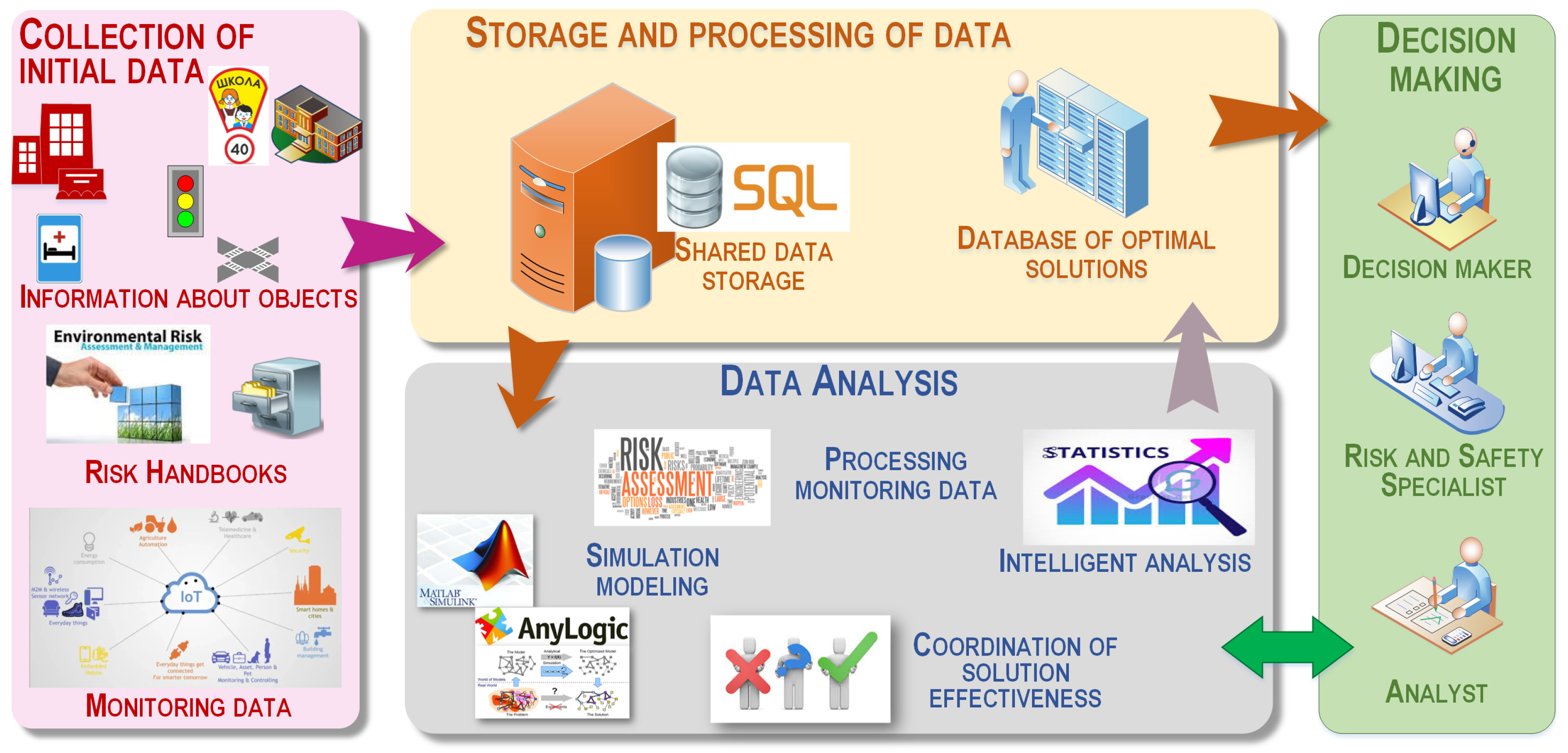
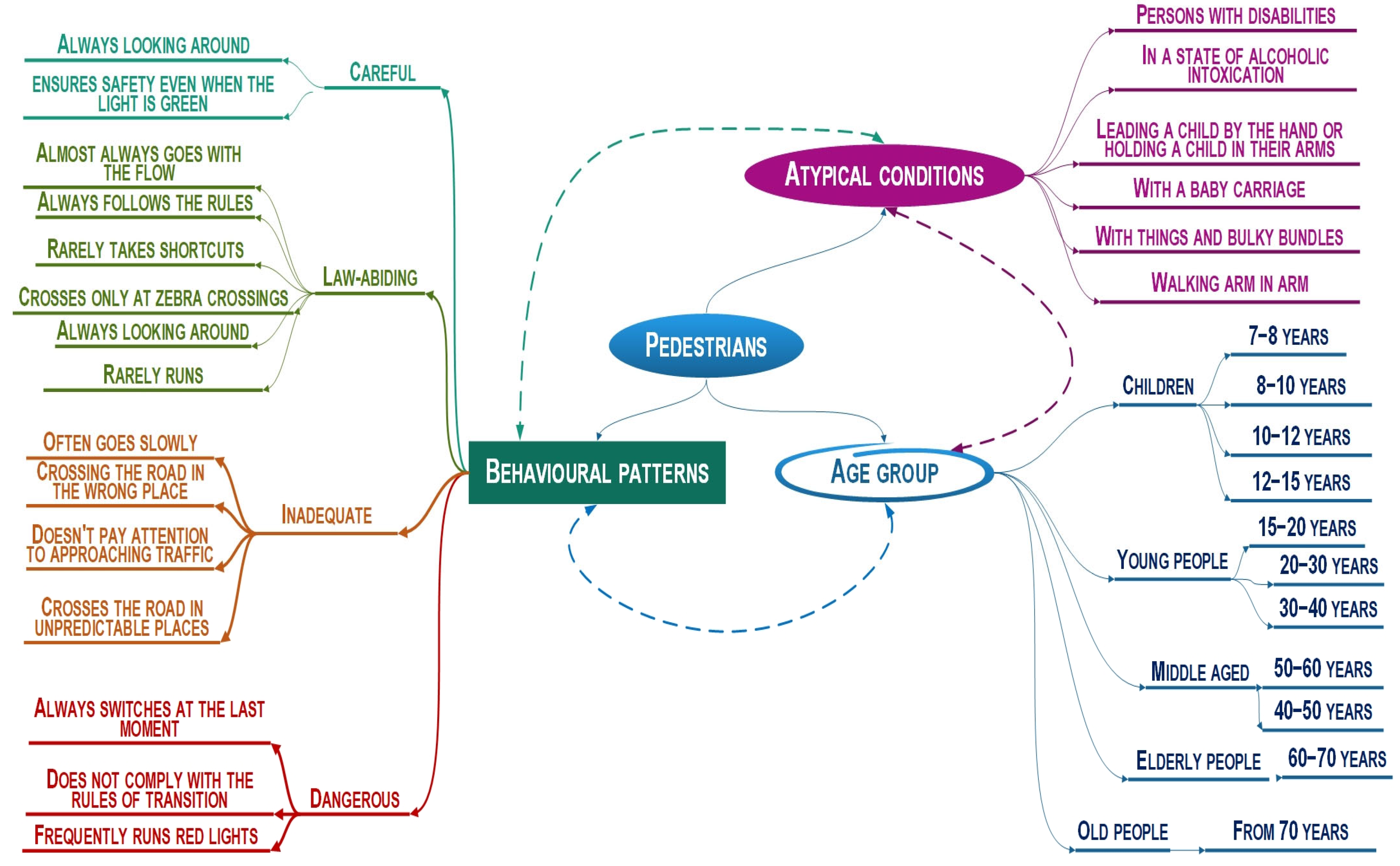
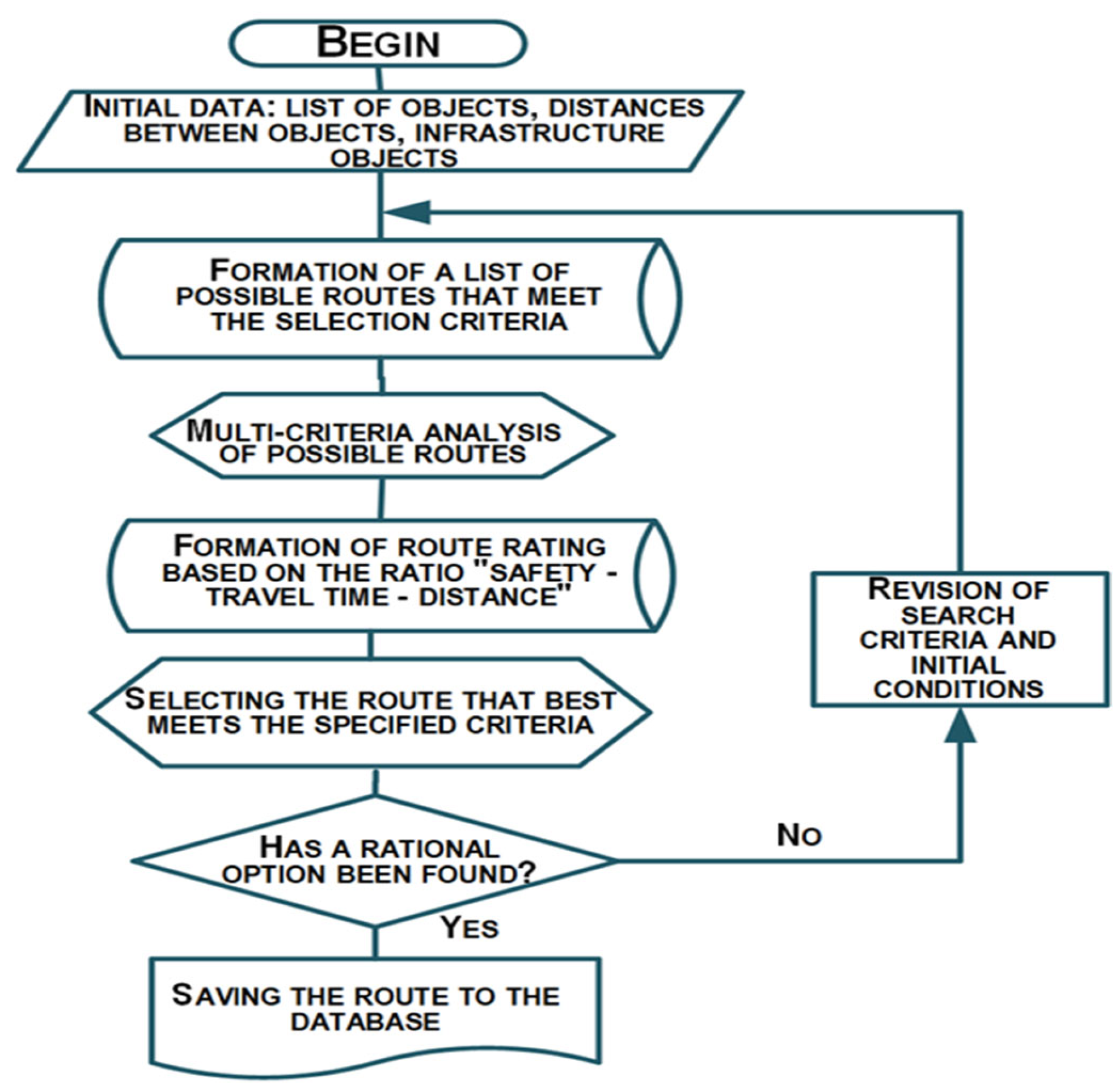
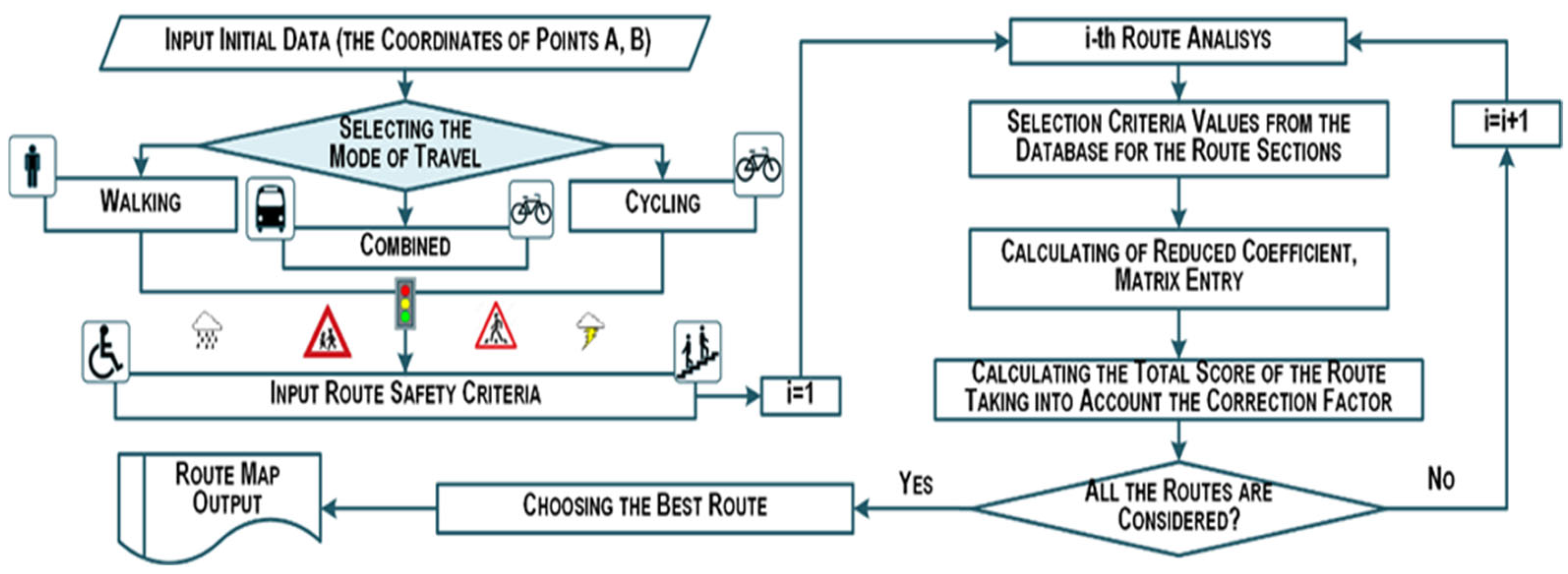

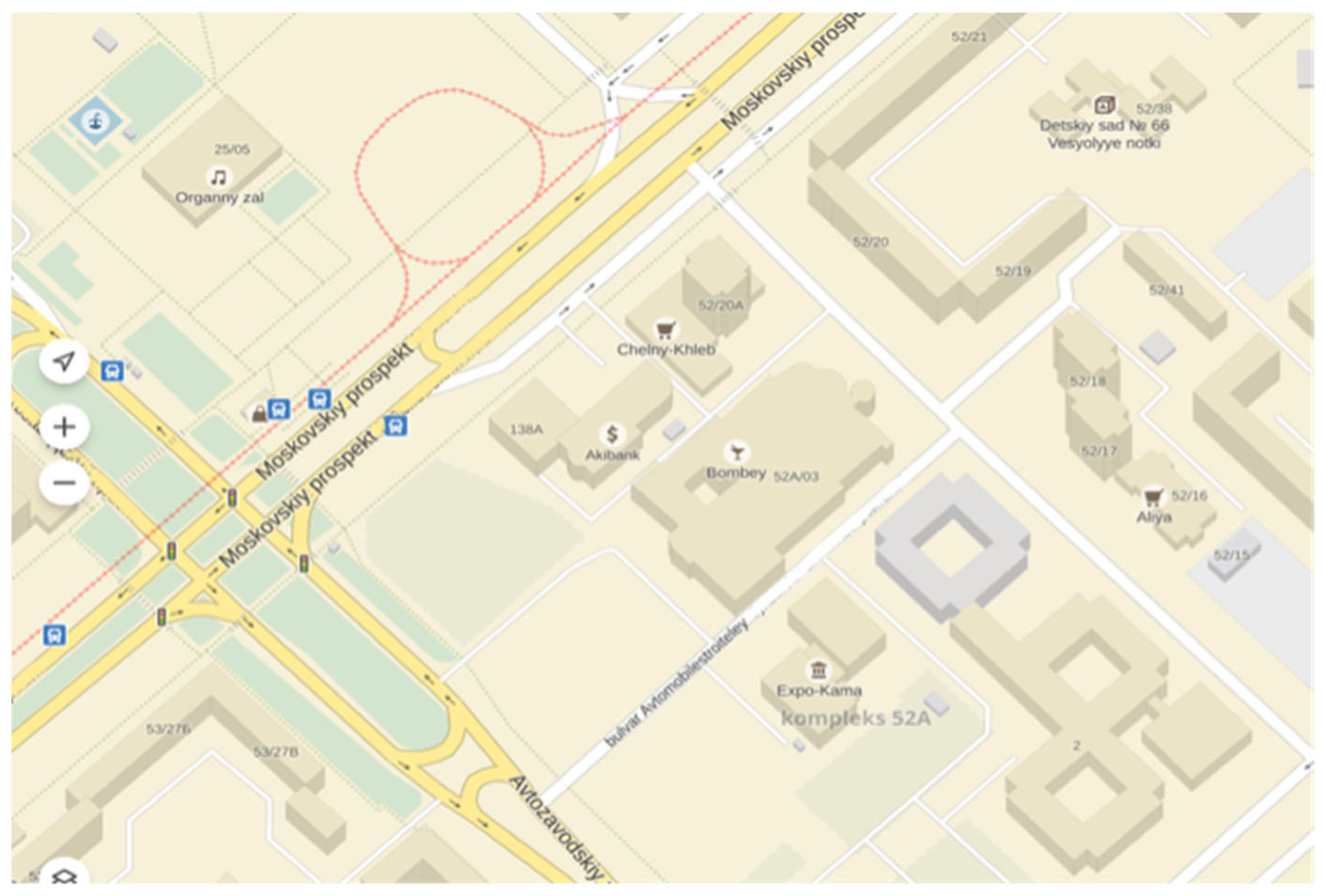
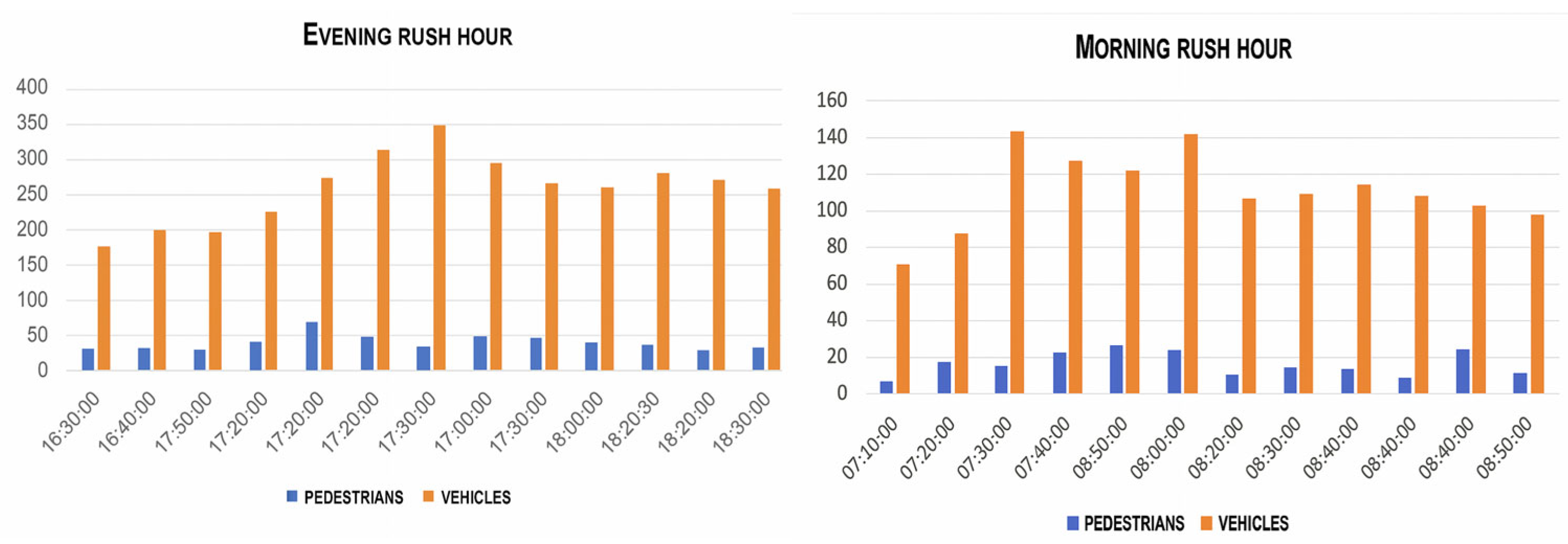
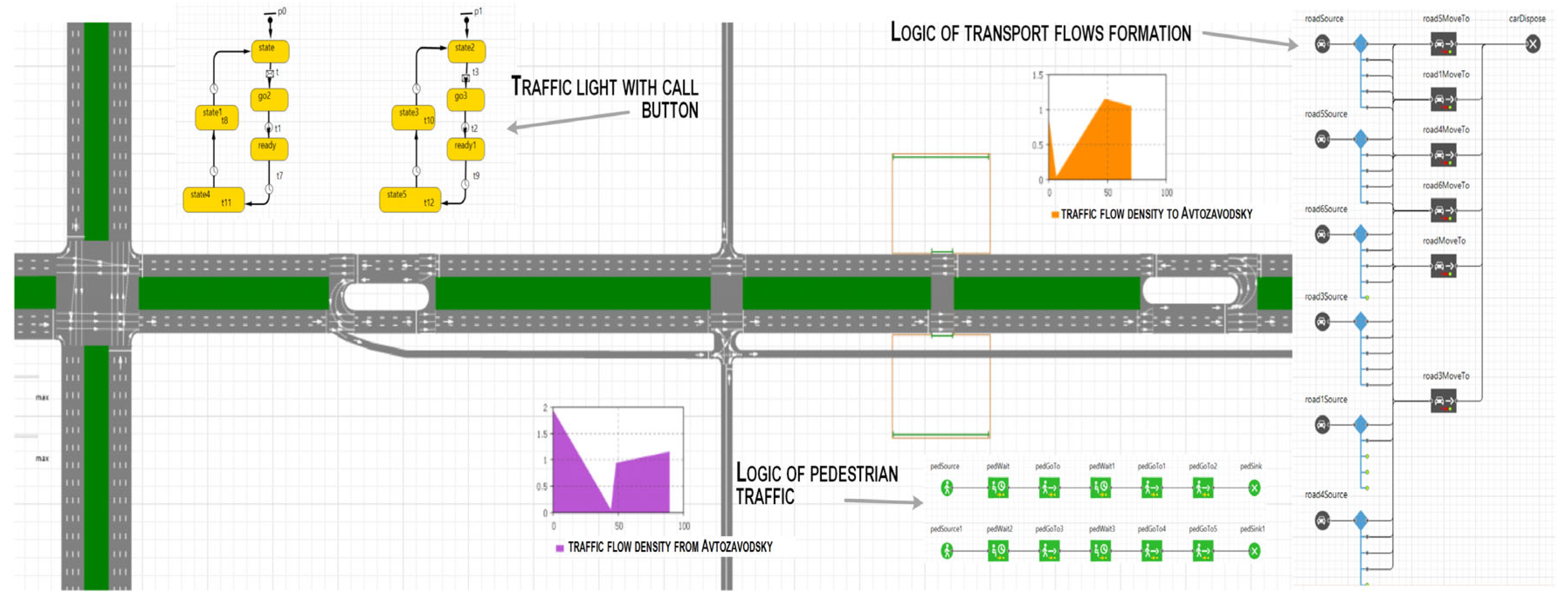
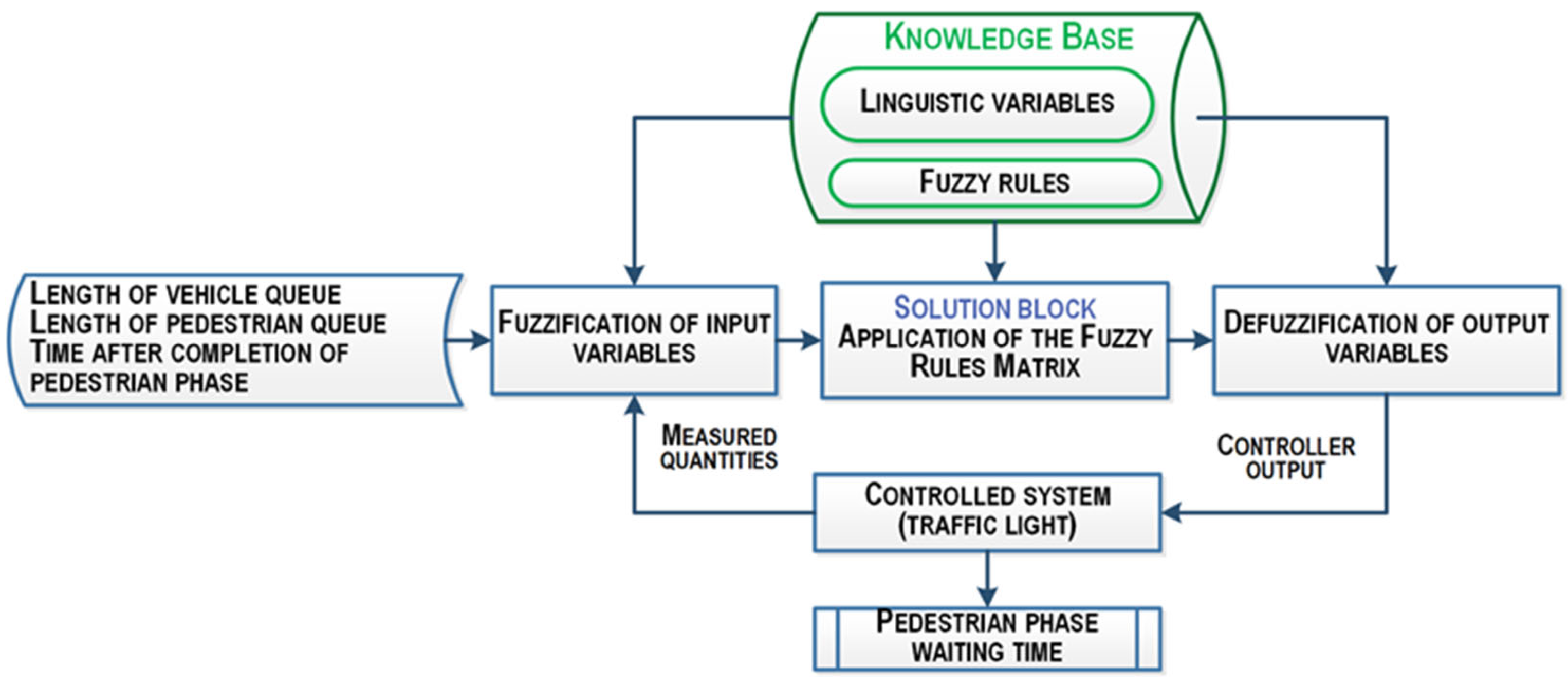
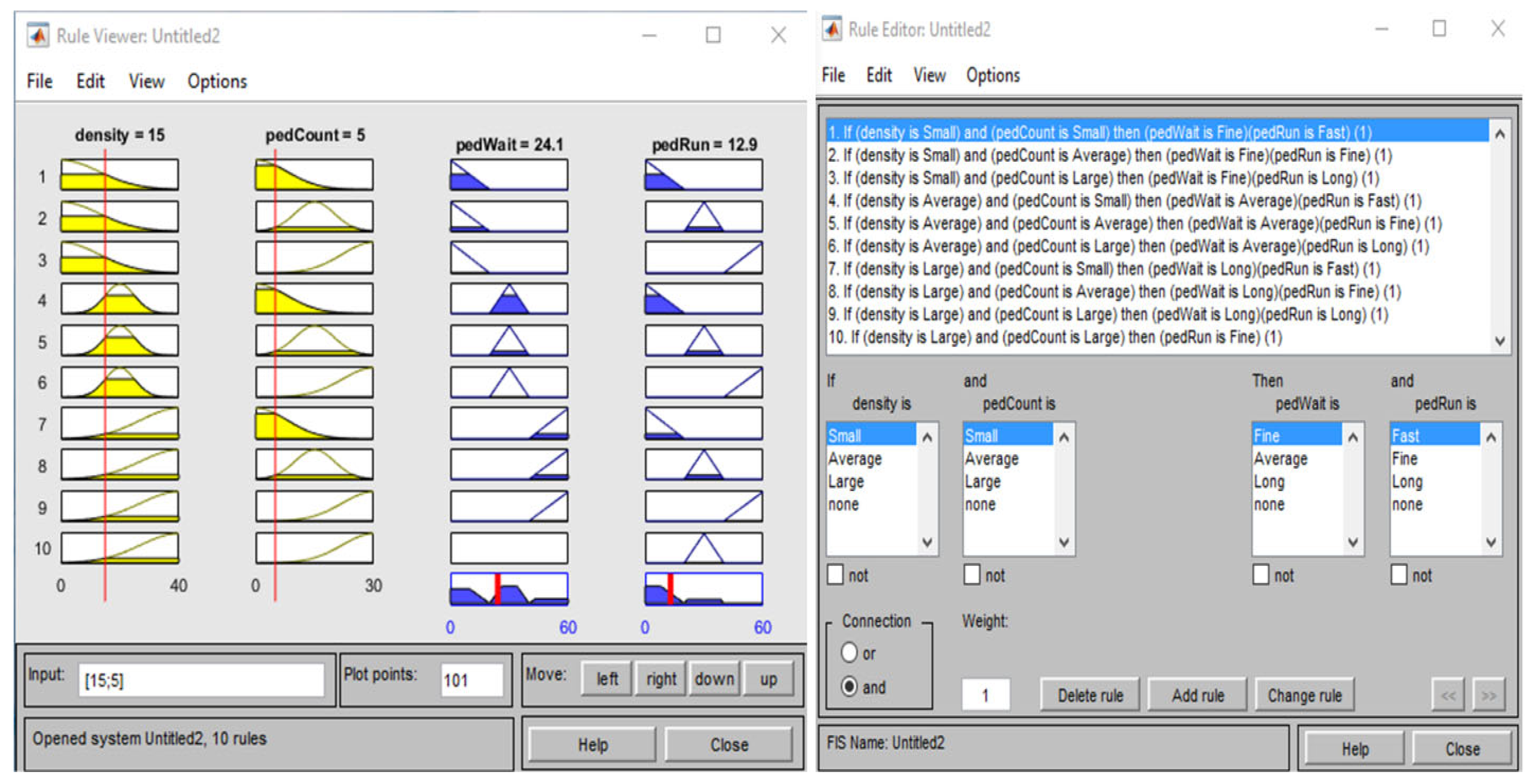

| No. in the List of References | Authors | City (Country, Region), Year | Social Factors | Infrastructure | Solution Methods/Models | Events/Training | |||
|---|---|---|---|---|---|---|---|---|---|
| Age | Perception | Barriers That Reduce Safety | Crossroad | Marking/Lighting | |||||
| [11] | Deluka-Tibljaš, A.; Šurdonja, S.; Ištoka Otković, I.; Campisi, T. | Croatia, 2022 | children | infrastructure solutions | lack of a universal mechanism | different types of intersections | different types | regression analysis, neural networks | targeted training |
| [12] | M. Gogola and J. Ondruš | Slovakia, 2020 | children and schoolchildren | under the supervision of parents or adults | absence of adults | different types | different types | surveys, observation | Targeted training |
| [13] | Ištoka Otković, I.; Deluka-Tibljaš, A.; Zečević, Đ.; Šimunović, M. | Croatia, 2024 | children and elderly pedestrians | unregulated | microsimulation (VISSIM) | Safety training | |||
| [14] | Ištoka Otković, Irena & Aleksandra, Deluka & Šurdonja, Sanja & Campisi, Tiziana. | Croatia, 2025 | children | different parameters | different types of intersections | neural network based models | Targeted training | ||
| [15] | Yang, J.; Gauli, N.; Shiwakoti, N.; Tay, R.; Deng, H.; Chen, J.; Nepal, B.; Li, J. | Australia, 2025 | vulnerable groups including children, older people and CALD communities | such as a language barrier, lack of knowledge of local traffic rules and differences in cultural approaches to safety | using mobile phones when crossing the road | different types of intersections | thematic analysis of articles | targeted communication is needed to address specific risks | |
| [16] | Habibzadeh, Mohammad & Mirabimoghaddam, Mohammad & Haghighi, Mojde & Ameri, Mahmoud | Iran, 2024 | different age groups | lack of correlation between perceived and infrastructure security | different types of intersections | safety training with economic empowerment | |||
| [17] | Kouchakinejad-Eramsadati L, Asgary A, Homaie Rad E, Hirshon JM, Ostadtaghizadeh A. | Iran, Canada, USA, 2025 | different age groups | different groups by age and behavior | different types of intersections | traditional content analysis with an inductive approach, data analysis using the Granheim and Lundman approach | Safety training | ||
| [18] | Soyoon Kim, Sangwon Choi, Brian H.S. Kim. | Seoul, 2024 | elderly | lack of pedestrian awareness | lack of separation of pedestrian and traffic flows | different types of intersections | lack of separation of pedestrian and traffic flows | MaxEnt (maximum entropy) model | safety training with infrastructure improvement |
| [19] | Lee, S.; Han, M.; Rhee, K.; Bae, B. | Korea, 2021 | different age groups | satisfaction | different types of intersections | binary logit model and ordered logit model | survey, satisfaction study | ||
| [20] | Bojan Marić, Krsto Lipovac, Miladin Nešić, Miroslav Đeri | Belgrade, 2021 | different age groups | countdown board | adjustable | motion video analysis | Safety training | ||
| [21] | Kopsacheilis, A., Politis, I. | Thessaloniki, 2024 | different age groups | lighting, traffic calming measures | lighting, traffic calming measures | traditional logistic regression models and artificial neural networks | Safety training | ||
| [22] | Swami, M.; Pathak, C.; Swami, S.; Jeihani, M. | USA, India, 2024 | schoolchildren | comprehensive improvement of the pedestrian school zone | parking on sidewalks, no barriers | lighting, traffic calming measures, widening of sidewalks | microscopic scenario modeling using the SFM model in the PTV Vissim/Viswalk software | training in road safety rules | |
| [23] | Mukherjee, Dipanjan & Kumar, Abhinay. | India, 2024 | different age groups | width of the roadway, presence of a curved section at the intersection, vehicle speed | presence of pedestrian traffic lights | width of the roadway, presence of a curved section at the intersection | Logit Models | Safety training | |
| [24] | Mukherjee, D. | India, 2025 | different age groups | pedestrian education level | inadequate infrastructure, vehicle speed | ANOVA Method for Pedestrian Risk Analysis | traffic police control | ||
| [25] | Prakash S, Karuppanagounder K. | India, 2023 | different age groups | age of pedestrians | non-linear route, no cars on the road | inadequate infrastructure | motion video analysis, binary logit model | traffic police control | |
| [26] | K.C., Hari & Shahi, Thusitha | Nepal, 2025 | different age groups | Pedestrian age, previous accident history, pedestrian behavior | low perception of safety | structured questionnaire survey | traffic police control | ||
| No. in the List of References | Authors | City, Country, Region, Year | Infrastructure | Solution Methods | ||
|---|---|---|---|---|---|---|
| Purpose of the Study | Intersection/Markings/Lighting | Models | Restrictions | |||
| [27] | Ristić, B., Bogdanović, V., & Stević, Z. | Doboj, Sarajevo, and Novi Sad, 2024 | assessment of the impact of pedestrian movement start time on the efficiency of pedestrian flow | adjustable transition | criteria-elimination and trade-off decision models for measuring alternatives and ranking | model sensitivity to input parameters |
| [28] | Santilli, D.; D’Apuzzo, M.; Evangelisti, A.; Nicolosi, V. | Italy, 2021 | Road Safety Risk Assessment | hybrid approach and innovative “moving observer” approach | We need to create conditions that support active transport, improve public health and advance equitable goals. | |
| [29] | Julijan Jurak, Mario Ćosić, Antonijo Tišljar, Ivan Neme | Zagreb, Republic of Croatia, 2026 | the possibility of creating zones with a speed limit of up to 30 km/h in urban areas | vertical and horizontal signaling registration and automatic traffic counters | drone video, processing tests in the Data software solution from Sky, processing of data on road accidents. | There are significant barriers to public acceptance, enforcement and compliance. |
| [30] | Ziółkowski, R.; Pérez-Acebo, H.; Gonzalo-Orden, H.; Linares-Unamunzaga, A. | Poland, Spain, 2024 | Changes in safety indicators (before and after) at pedestrian crossings | pedestrian crossings with additional lighting | “before and after” method | Comparison of data on night and daytime accidents is necessary |
| [31] | Kruszyna, M.; Matczuk-Pisarek, M. | Poland, 2021 | Evaluation of infrastructure solutions to reduce speed | devices from the group of “speed control measures” and “means for intermediate transitions” | Determination of the main characteristics of road traffic (speed and intensity) using the SR4 device | Only issues of traffic management without taking into account the impact on vehicles and pedestrian behavior |
| [32] | Cieśla, M. | Poland, 2021 | problems of improving children’s safety on the roads as pedestrians and cyclists in a smart city | pedestrian and bicycle infrastructure | diagnostic survey, multi-criteria assessment of infrastructure solutions | |
| [33] | A. Charef, Z. Jarir and M. Quafafou | Marrakesh, Morocco, 2024 | determine the optimal distance between roundabouts and pedestrian crossings | roundabouts and pedestrian crossings | Vissim modeling | the presence of pedestrian crossings adds complexity, requiring careful planning to achieve a balance |
| [34] | Y. Zhang, X. Zhang, Y. Fujinami and P. Raksincharoensak | Tokyo, Japan, 2024 | solutions to collision avoidance problem | mixed traffic, differences between streets and pedestrian areas | particle swarm optimization (PSO) to generate optimal parameters of a dynamic vehicle model based on the social force model (SFM) | For simplicity, a point mass vehicle model was used |
| [35] | Chi Zhang; Janis Sprenger; Zhongjun Ni; Christian Berger | Gothenburg, Sweden, 2024 | improving traffic safety at unregulated crossings | without “zebra” and using “zebra” | Application of neural network and simulator for scenario study | observed behavior may be influenced by cultural effects |
| [36] | E. Mátyás and L. Szabó | Cluj-Napoca, Romania, 2024 | improving traffic safety | intelligent system of additional lighting of pedestrian crossings based on round LEDs mounted in the ground | The Doppler effect has also been used to determine the direction of a pedestrian’s movement. | |
| [37] | M. Pogatsnik, D. Fischer, L. Nagy and S. Dora | Szekesfehervar, Hungary, 2020 | increasing visibility in heavy fog or rain | intelligent pedestrian crossings based on alarm signals generated by sensors. | The system projects a virtually uniform laser plane over the roadway | To obtain accurate traffic data, the sensor system needs to be expanded. This may lead to increased energy consumption. |
| [38] | K. S. Wickramasinghe and G. U. Ganegoda | Katubedda, Sri Lanka, 2020 | improvement of time-based traffic lights and push-button traffic lights | improvements to the traditional traffic light system. | Image processing technologies for pedestrian detection Haar Cascade Classifier | it will be possible to improve the trajectory determination function by using a voting system to predict the location of a pedestrian in a given period of time |
| [39] | S. Deshmukh, A. Parwekar, B. Danej, N. A. Chavhan, R. Agrawal and C. Dhule | Nagpur, India, 2023 | improving intelligent traffic lights | coordination of traffic lights at intersections | deep learning methods data learning strategies using data mining and image processing techniques | The quality and quantity of data used to train algorithms determine the success of these methods. Implementing these strategies requires significant investment in infrastructure such as communication networks, sensors, and cameras. |
| [40] | L. Gao | Xi’an, China, 2022 | construction of intelligent pedestrian crossings “zebra” | Activated when pedestrians are detected | convergence of cloud technologies and networks | |
| [41] | Lozano Domínguez, J.M.; Redondo González, M.J.; Davila Martin, J.M.; Mateo Sanguino, T.d.J. | Huelva, Spain, 2023 | intelligent pedestrian crossing | speed bump design | Sensor fusion and machine learning methods for pedestrian and driver recognition | |
| No. in the List of References | Authors | City, (Country, Region), Year | The Purpose of Behavioral Research | Behavioral Factor | Infrastructure (Intersection/Markings/Lighting) or Vehicle | Solution Methods | |
|---|---|---|---|---|---|---|---|
| Models | Limitations and Future Work | ||||||
| [42] | Ezzati Amini, R.; Katrakazas, C.; Antoniou, C. | Munich, Germany; Athens, Greece 2019 | understanding effective communication methods and the factors that influence pedestrian interactions and decision making | distraction, lack of communication with the vehicle driver | A holistic approach to modeling interactions at road crossings is presented and discussed. | It is necessary to first detect distracted pedestrians and then respond appropriately to avoid conflict | |
| [43] | Kim, D.; Kim, H.; Mok, Y.; Paik, J. | Seoul, Korea, 2021 | Detect and track pedestrians to extract information about them in real time | detecting abnormal road behavior such as trespassing, falling and violence | video surveillance system | The object detection network uses YOLOv4, a tracking algorithm to estimate the coordinates of an object | can be improved with additional algorithms such as pose estimation and further dataset tuning |
| [44] | S. Deokar and S. Khandeka | Pune, India, 2022 | creating a driver assistance system for ADAS vehicles to improve pedestrian safety and reduce pedestrian accidents | recognizes a pedestrian moving in a certain direction | car cctv system | Convolutional neural networks are used to train and classify both binary and categorical pedestrian data | difficulty in forming a database of images of pedestrians |
| [45] | Giannoulaki, M.; Christoforou, Z. Pedestrian | Patras, Greece, 2024 | factors influencing pedestrian walking speed are being studied | The factors influencing pedestrian walking speed are studied, classifying them into pedestrian flow characteristics, pedestrian attributes, layout configuration, environmental conditions and pedestrian behavior patterns | a comprehensive review of the literature studying pedestrian walking speed in different environments and conditions, classification of factors and synthesis of results using meta-analysis | Factors such as environmental conditions, technological limitations and human error may introduce bias or inaccuracies into the data collected. | |
| [46] | Sajewicz, J.; Dziuba-Słonina, A. | Wroclaw, Poland, 2023 | does using a mobile phone while walking affect walking speed and other parameters | increased risk of accidents at pedestrian crossings and tripping while walking while texting on a smartphone | Experiment in the measurement workshop using the FDM−1.5 Zebris dynamograph platform | More respondents are needed. The survey can be conducted in other age groups (primary and high school students). | |
| [47] | R. Hasan, M. A. Hoque, Y. Karim, R. Griffin, D. C. | Birmingham, AL, USA, 2022 | warning pedestrians distracted by their smartphones with a visual and/or sound signal | increased risk of accidents at pedestrian crossings | StreetBit system at the intersection: (1) BLE beacons; (2) StreetBit mobile application; (3) internal server for data storage | StreetBit mobile apps for Android and iOS | In the future, it is planned to develop a system with fewer beacons. It is necessary to develop safe behavior on the road. |
| [48] | A. Marrapu | VA, USA, 2024 | warning with a mobile app to prevent road accidents | distractions while walking, especially when using a mobile phone | The application uses Google API Activity for tracking user activity and Map API for defining paths and transitions | ||
| [49] | Mikusova, M.; Wachnicka, J.; Zukowska, J. | Zilina, Gdansk, Poland, 2021 | Improving pedestrian safety | use of mobile devices and headphones on pedestrian crossings | Observation, survey by recording data on a census form, where pedestrians were grouped by estimated age to assess pedestrian safety risks | limited time and number of measurements taken | |
| [50] | Y. Koike and Y. Tanjo | Japan, 2024 | Improving pedestrian safety | falls or collisions of visually impaired persons | the instrument consists of a cartographic information system and a navigation system, which uses optical beacons and their receiver | using images obtained with MY VISION and deep learning. | There are limitations in recognizing color markings of routes. |
| [51] | S. Caldera, V. Madushika, S. Herath, S. Alwis, S. Thelijjagoda and J. Krishara | Sri Lanka, 2023 | obstacle detection, identification of free spaces, recognition of road signs and assistance when crossing the road | Help for the visually impaired | comprehensive smartphone application for the visually impaired | React was used to develop the mobile application Native. The code was written using Python and TensorFlow to build machine learning models. | To improve the accessibility of the application for visually impaired users, future research may consider developing smart glasses. |
| [52] | W. -J. Chang, L. -B. Chen, C. -Y. Sie and C. -H. Yang | Tainan, Taiwan, 2024 | assisting visually impaired consumers to safely use marked pedestrian crossings or zebra crossings | Wearable assistance system based on AI edge computing methods for recognizing zebra crossings at intersections | an AI-based assistance system consisting of a pair of smart sunglasses, a smart waist-mounted device, and a smart walking stick | AI-based deep learning method is used | |
| [53] | Delvis Yendra, Narelle Haworth, Natalie Watson-Brown | Australia, 2024 | Comparison of factors influencing pedestrian safety at bus stops in countries with different income levels | systematic review | It is recommended to focus on developing additional safety measures to identify dangerous bus stops | ||
| [54] | Rezwana, S., Shaon, M. R. R., Lownes, N., & Jackson, E. | USA, 2025 | studying the perception of autonomous vehicles and pedestrian reactions | Safer coexistence between pedestrians and driverless cars | Pre-survey to assess public perception, immersive simulation of real traffic scenarios in a VR environment, post- experimental survey | Transport authorities can develop more effective communication strategies and educational programs | |
| [55] | Y. Li, H. Zhou, S. Fu and W. Wang | Wuhan, China, 2023 | study of the degree of interaction between vehicles and pedestrians | obtaining data on pedestrians’ intention to take risks when crossing the street | K-means clustering method, Risk taking survey, Leuckart scale processing | the number of questionnaires collected is small, the study participants do not have a clear understanding of the driver assistance function in cars | |
| [56] | R. Greer, S. Desai, L. Rakla, A. Gopalkrishnan, A. Alofi and M. Trivedi | San Diego, USA, 2023 | preventing collisions with pedestrians | CHAMP can reduce risks to pedestrians in poor visibility | The advantages of CHAMP: (1) online autonomous vehicle detectors can be used; (2) any car with a navigation system can benefit from the safety recommendations. | CHAMP can process information, apply noise reduction and threshold, online pedestrian detection aggregation systems based on maps learning pedestrian locations | |
| [57] | A. Omri, F. Sbiai, S. Sayahi and H. Besbes | Ariana, Tunisia, 2024 | detection and classification of pedestrian behavior in urban environments | various types of pedestrian movement including “walk”, “cross the road”, “hesitate” and “raise hand” | Using low-resolution 4D radar in real urban environments | Pedestrian Clustering Using Machine Learning and Deep Learning | further development of the algorithms, including expanding the dataset with more realistic scenarios and collecting vehicle data to improve efficiency |
| Traffic Flow Parameters | Unregulated Crossing | Adjustable Crossing | |
|---|---|---|---|
| Not During Rush Hour | During Rush Hour | ||
| average traffic density | 121 | 137 | 168 |
| average traffic speed | 71 | 70 | 66 |
| probability of accident | 0.67 | 0.29 | 0.24 |
| Avenue | Red | Green | Arrow |
|---|---|---|---|
| Avtozavodsky | 27 | 25 | 23 |
| Moskovsky | 25 | 27 | 23 |
| Term Set Value | Membership Functions of Input Variables | Membership Function of Output Variables | |||
|---|---|---|---|---|---|
| Number of Vehicles, Nq, Units | Number of Waiting Pedestrians, People | Time to the Beginning of the Red Phase, Tp, s | Pedestrian Phase Waiting Time, s | Transition Time, s | |
| Small | 0–13 | 0–8 | 1–7 | 0–20 | 0–20 |
| Medium | 13–27 | 8–21 | 7–15 | 20–40 | 20–40 |
| Large | 27–40 | 21–30 | 30 and more | 40–60 | 40–60 |
Disclaimer/Publisher’s Note: The statements, opinions and data contained in all publications are solely those of the individual author(s) and contributor(s) and not of MDPI and/or the editor(s). MDPI and/or the editor(s) disclaim responsibility for any injury to people or property resulting from any ideas, methods, instructions or products referred to in the content. |
© 2025 by the authors. Licensee MDPI, Basel, Switzerland. This article is an open access article distributed under the terms and conditions of the Creative Commons Attribution (CC BY) license (https://creativecommons.org/licenses/by/4.0/).
Share and Cite
Makarova, I.; Gubacheva, L.; Gabsalikhova, L.; Mavrin, V.; Boyko, A. Developing Intelligent Integrated Solutions to Improve Pedestrian Safety for Sustainable Urban Mobility. Sustainability 2025, 17, 8847. https://doi.org/10.3390/su17198847
Makarova I, Gubacheva L, Gabsalikhova L, Mavrin V, Boyko A. Developing Intelligent Integrated Solutions to Improve Pedestrian Safety for Sustainable Urban Mobility. Sustainability. 2025; 17(19):8847. https://doi.org/10.3390/su17198847
Chicago/Turabian StyleMakarova, Irina, Larisa Gubacheva, Larisa Gabsalikhova, Vadim Mavrin, and Aleksey Boyko. 2025. "Developing Intelligent Integrated Solutions to Improve Pedestrian Safety for Sustainable Urban Mobility" Sustainability 17, no. 19: 8847. https://doi.org/10.3390/su17198847
APA StyleMakarova, I., Gubacheva, L., Gabsalikhova, L., Mavrin, V., & Boyko, A. (2025). Developing Intelligent Integrated Solutions to Improve Pedestrian Safety for Sustainable Urban Mobility. Sustainability, 17(19), 8847. https://doi.org/10.3390/su17198847









